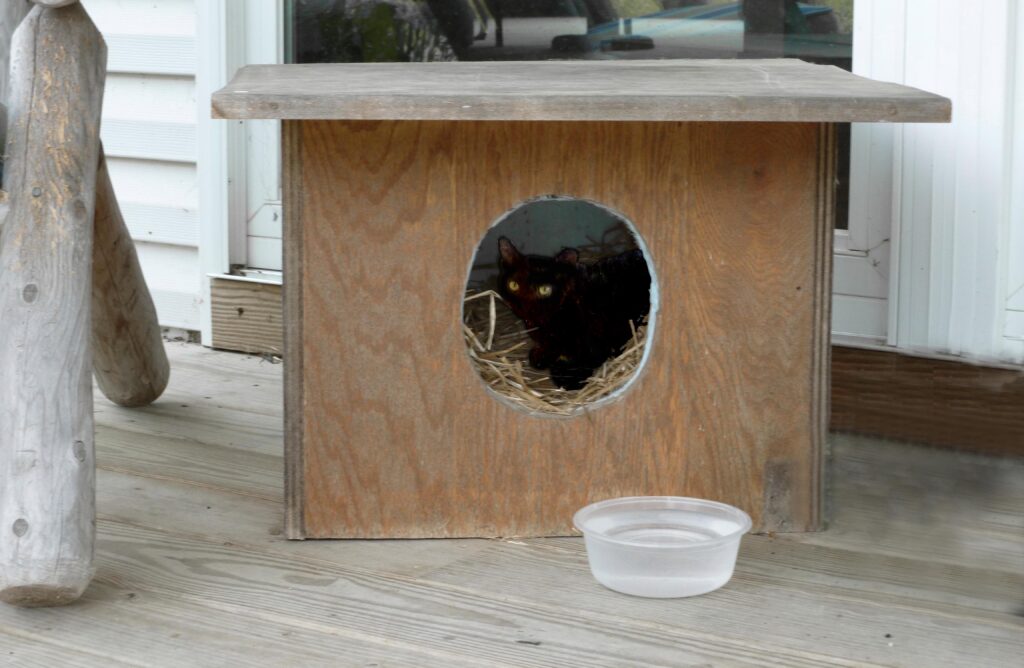If it feels cold to you, it feels cold to animals too. Don’t be fooled into thinking that because they are animals with fur, and many wild animals live outdoors all the time and survive, the cold is not only tolerable but comfortable for them. Many wild animals die in weather like this, and unfortunately so do community cats. Here are a few ways you can help them survive cold winter weather and severe winter storms.
Don’t take for granted that cats can survive outdoors in severe weather
Community cats are not wild animals despite the fact they are living outdoors—they are domestic animals and aren’t hardwired to build a den or nest for winter protection in the way wild animals do. We need to help them by providing shelter, food and water.
Cats may tolerate cold for a while, but their small bodies lose heat quickly and extremities like tails and ears can easily be lost to frostbite. Kittens and young cats are less tolerant of cold than adults, likewise older animals are less tolerant. Always make sure they have shelter and food and water that is not frozen or covered with snow or ice.
Sturdy insulated shelter
If you’re caring for cats who live outdoors, they should have shelters of some sort at all times, but especially at this time of the year. Many shelters are made from Rubbermaid containers with smaller containers inside and styrofoam or straw between the two containers for insulation, others from styrofoam coolers wrapped with heavy plastic garbage bags, others are wood and other building materials. No matter what sort of shelter:
- They should be insulated by a solid material like styrofoam that is sealed with tape and/or caulking to form a complete barrier to wind, cold and moisture.
- They should be filled with dry straw that the cats can nestle into, not hay which is animal feed and has a certain amount of moisture, and not blankets which hold moisture and can develop mold and mildew.
- Entrances should face away from the wind and even have a flap over the doorway to help keep cold out.
- They should be placed in a safe area away from traffic or dangers where cats can enter and leave to access food and water without impediment.
- They can be raised off the ground and insulated underneath to keep from absorbing cold from soil or pavement.
If snow falls, clear snow away from the area around their shelters so they can easily access any part of the area, and so that when the snow melts it doesn’t leave water, mud or ice behind for the cats to walk on and track into their shelter, or to present a danger to you when you feed and care for them.
If shelters are placed in a covered area, such as under a deck or porch, with electricity available, you can also consider a warming light such as ones used for poultry or livestock.
Food
Cats living outdoors need to build up a layer of fat to help insulate themselves in cold weather. Dry food is convenient, but wet food is more nourishing for them, so try to provide wet food at least once a day when the weather gets cold.
Place food bowls in a protected area so food won’t be covered with snow or wet with rain or sleet, and also so that they can eat in comfort out of the wind and weather.
Many times there is no chance for electricity to keep wet food from freezing, so either a few extra trips to refill dishes or a non-electric warming pad helps to keep food edible. To
help it stay edible longer, add a little hot water when you serve it—this will also make the scent of the food stronger and encourage the cats to come and eat right away.
If electricity is available, use a heated food bowl or a food warmer that’s appropriate for your feeding area.
Water
Animals can survive days, even weeks, on existing body fat, but a few days without water causes severe dehydration and organ damage or failure, often irreversible.
Just like food, if there is no chance for electricity to keep water from freezing, a few extra trips to refill dishes with hot water to keep it liquid longer or a non-electric warming pad helps to keep water liquid. Make sure dishes are non-breakable and are stable so they can’t be tipped to spill out the water.
If electricity is available, use a heated water bowl.
Give community cats indoor shelter if possible
Often community cats are accustomed to their caretaker and may be amenable to simply coming into a sheltered area for the duration of a storm, then returning back outside when the worst is over. Cats who are very young or older, or with any obvious injuries or illnesses, need the most protection. If you could make arrangements for them and any cats who seem amenable to come inside during the most intense cold, even in separate areas or large cages, you could save lives.
Bringing them into your home is risky because most people who would do this often have other cats and you need to keep everyone separated for health and social reasons and could result in health and behavior issues, so you would always keep the populations separate.
A garage will work if the floor is clear of vehicle fluids and residue. Even a shed or outdoor area where cats would be completely out of the elements for the duration of a storm would keep them until the worst of it is over. Depending on how socialized they are you might just open the door and invite them in, or you might need to lure them in with food, adding beds, food, water and litterboxes.
Resources
Alley Cat Allies: Winter Weather Tips (www.alleycat.org/community-cat-care/winterweather-tips/)
Top Ten Tips on Caring for Ferals in Winter (www.aspcapro.org/resource/spay-neuterferal-cats-starting-program/top-ten-tips-caring-ferals-winter) from the ASPCA



